Organic redevelopment in the city
In Huffington Post, Frank Gruber reviewed the new American Planning Association book, Grid/Street/Place: Essential Elements of Sustainable Urban Districts, which I've wanted to get, but haven't gotten around to it. Note that "organic development" is revitalization that results without a focused revitalization or "sector" or "neighborhood" plan. One of his criticisms of the book is that it doesn't adequately address organic development. From the review:
Although the dynamism (and, lamentably, the dysfunction) of Los Angeles is characteristically expressed in individual developers' small and often idiosyncratic projects spread around the grid, the book is weighted in favor of large planned developments. ...
My only disappointment with the book is that contains only a few examples of places that developed "organically" (i.e., as a result of pluralistic decision-making) in recent years on top of an existing layout of streets.
In DC, over the period from the early 1960s to about 2003, most neighborhood revitalization had been organic, spurred on by urban pioneers attracted to living in the city, mostly in historic residential single family buildings (usually attached rowhouses). But this had been a phenomenon of working with the extant housing stock, involving renovation sure, but very little new construction.
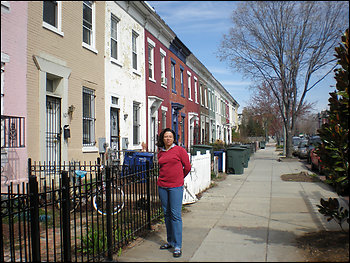
In Shaw, Marie Maxwell's 1874 rowhouse is on a colorful block of "darn cute" houses. Washington Post photo.
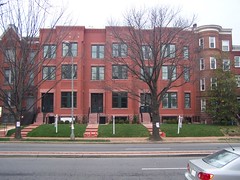
Infill rowhouses on the north side of the 600 block of Maryland Avenue NE, in place of a church building dating from the 1940s. On the other hand, most of the infill new construction in the area north of Maryland Avenue over the past 25 years has been pretty bad. These buildings are quite nice, and of course, more expensive.
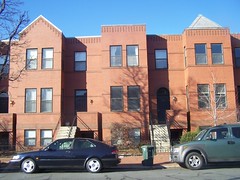
These were constructed around 1987, and they aren't that bad, compared to buildings further north. These are at the NE corner of 4th and F Streets NE.
During this same period, in commercial districts, most new construction over this period was in place of buildings that had been destroyed during the riots, and the site design typically was suburban and automobile-centric in orientation, ignoring urban design and placemaking considerations, and further diminishing the quality of the commercial districts in the city, and did not yield significant positive contributions to overall neighborhood revitalization.
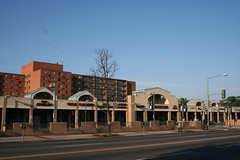
In the northeast quadrant, the H Street Connection shopping center, parking fronted, and the block senior housing apartment building behind it were planned and built as part of the post-riot H Street Urban Renewal Plan. Despite more than $100 million in revitalization investments made in the H Street corridor in the 1970s and 1980s, the neighborhood did not begin to experience significant revitalization until broader changes in trends that began to favor urban living, the construction of the infill subway station at Florida Avenue, which spurred an influx of higher demographic residential ownership north of H Street, to some extent the H Street Playhouse and the Atlas Theater (the H Street Community Development Corporation, which had owned the theater building for many years, had suggested tearing down part of the building complex for parking), and the entry of tavern and nightlife impresario Joe Englert, who bought a bunch of buildings and has been putting interesting destination establishments inside, remaking the H Street commercial district in the "Atlas District."
Since 2003, stunted a bit by the recent real estate crash, neighborhood revitalization, mostly in the northwest quadrant, has been spurred by the addition of large numbers of multiunit condominium and apartment buildings located proximate to (heavy rail) transit, and supplemented some by high quality retail infill development. (Note that more suburban- and automobile-oriented redevelopment projects in the southeast and far northeast quadrants have been less successful.)
High quality infill development has tended to be "produced" in the northwest quadrant (not everywhere). It's been much harder to achieve in other areas of the city. Likely this is due to the relatively higher value of location in the northwest quadrant, so even with higher land costs, demand is higher, justifying higher prices, which in turn allows developers to spend more money on high quality design and materials. In locations that are in relatively less demand, developers stint on the quality of the design on the outside of the building, as well as inside, to bring the building "online" at a price where the developer can make a profit, but at the cost of failing to provide significant "increasing returns" to the place values of urban design, placemaking, and neighborhood revitalization.
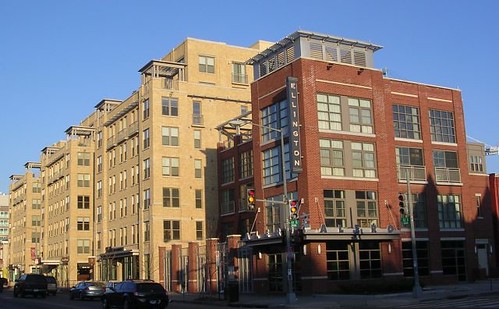
The Ellington Condominium building on U Street NW, built by Donatelli and Klein, is a high quality infill building on U Street that has spurred revitalization in the eastern side of the 14th Street corridor. Photo by Eye Captain.
Here's my response to Frank's review
As for your point about "organic" development, in my experience, which I admit is relatively limited, my sense is organic (re)development that includes significant amounts of new construction is more about adaptive reuse of extant places, complemented by (hopefully high quality) infill.
I think the evidence would be that without overarching design guidelines/smart code type requirements/focused commercial district revitalization programs, and of course having incredibly progressive developers and property owners, having organic development result in quantum improvements that are truly significant happens very rarely.
Where it changes is where there is a lead developer who (1) cares about and understands quality; (2) is willing to work with historic (designated or eligible) buildings in a sensitive manner; and (3) has acquired enough properties to generate a critical mass of positive behavior on the part of other developers, property owners, and business proprietors.
The place in DC where I see high quality organic development that truly qualifies as organic is 14th Street NW, from P Street (with a little southern bleed towards Thomas Circle) up to about Florida Avenue (north of U Street) as well as along U Street.
The lead developer was Abdo. For non-downtown, it's one of only a couple areas in the city where there is a large conglomeration of "old" larger footprint buildings (DC has but a handful of the kinds of old industrial buildings, and none of the big industrial complexes that typified traditional center cities, the kinds of buildings that are perfect for big adaptive reuse projects)--many had served as auto dealerships back in the 1920s. And while Abdo never had a whole lot of property, he set a high bar for design quality, which tended to rub off on the new projects. This effort was complemented by the successful recruitment of a Whole Foods Supermarket onto a key parcel, which helped generate a lot of energy and renewed sampling of the area, increasing the willingness to live there, which supported the addition of condominiums and apartment buildings.
Because DC is a relatively small place, improvements in the retail side (Whole Foods excepted) have really lagged. Many business failures have occurred. A new anchor, the furniture store Room & Board, has come in and that should help draw more customers from outside the immediate retail trade area, because this is their only store in the region.
An early entrant into this neighborhood was the Studio Theater, but it was a couple decades before Abdo. The theater helped stabilize the neighborhood, but didn't have the kind of heft and impact that lead to improvements in the commercial district. It took Abdo's projects (mixed use, primarily residential) to start the process in earnest.
Labels: land use planning, neighborhood planning, urban design/placemaking, urban revitalization



0 Comments:
Post a Comment
<< Home